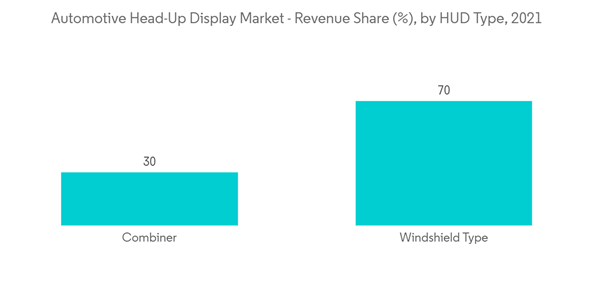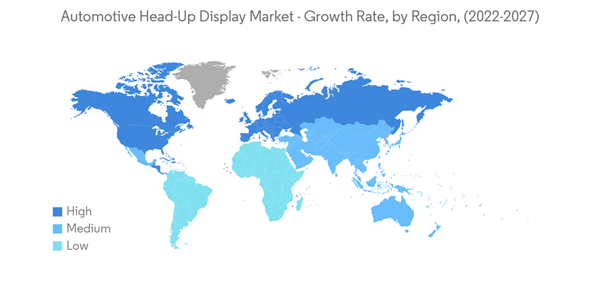The automotive head-up display (HUD) market registered about USD 1.45 billion in 2024 and is expected to reach over USD 4.99 billion by 2029, registering a CAGR of around 24% during the forecast period.
In January 2021, Panasonic Automotive launched its latest augmented-reality HUD capable of displaying lane edges, objects on the road, and other information important to drivers. The HUD runs in AI and shares information with the driver. The new HUD can determine by itself whether the barrier is a vehicle, pedestrian, or trash can.
In September 2020, DigiLens unveiled its Ultra-Compact CrystalClear™ AR HUD, compatible with any auto dashboard. The CrystalClear™ AR HUD has around 15° x 5° field-of-view and is expected to open the gateway for holographic-assisted navigation to any vehicle.
Besides these, several key OEMS are also participating actively in the market, and such developments are likely to have a strong positive impact on the market. For instance,
In June 2021, Hyundai Motor Company introduced a less head-up display (HUD) that features optical glass installed in the dashboard and angled toward the driver, which ensures better vision.
In 2021, Audi announced the introduction of its latest reality (AR) heads-up-display (HUD) in the Audi Q4 e-tron electric vehicle. The generated virtual image will appear to float in space about ten meters ahead of the driver. The company claims that the overlaid image will assist in conveying information at a rapid pace and without confusion.
This product will be delivered within 2 business days.
Key Highlights
- The COVID-19 pandemic had a negative impact on the market in 2020 due to a halt in manufacturing activities and supply chain disruptions due to restrictions imposed by governments worldwide. However, post-pandemic, as economic activities restored, the demand started gaining momentum owing to notable growth in production and sales of vehicles across major countries like the United States, China, India, and others.
- The demand for high-end luxury and mid-size cars with advanced safety features, including head-up displays, coupled with significant growth in the use of smartphones and navigation systems, is anticipated to enhance demand in the market. Further, the introduction of stringent government regulations regarding safety, continuous reduction in the price of head-up displays, advancement in technology, and organic growth in automobile production will further boost the growth of the market during the forecast period.
- Automobile manufacturers and HUD market players are working towards improving the present head-up display system. Present HUDs are equipped with a geological positioning system (GPS) that can display warning and error messages on the windshield. Implementation of strict safety regulations by the government coupled with increasing sales of luxury cars, the adoption of HUD in luxury vehicles is on the rise as a part of the driver and passenger safety systems to offer lucrative opportunities for players in the market.
- North American region is expected to dominate the market studied during the forecast period, followed by Europe and Asia-Pacific region. Increased consumer spending on luxury cars and a growing emphasis on safety are expected to support the growth of automotive HUDs in these regions.
Automotive Head-up Display (HUD) Market Trends
Increased Adoption Rate of Windshield HUD to Occupy Significant Share in the Market
- Automobile manufacturers and HUD suppliers have been continually working on developing better systems for cars. These HUDs have evolved beyond the bulky navigation that was available a few years ago. These systems are now capable of displaying compass directions, warning messages, radio information, etc., on the windshield.
- Utilizing advanced technologies, like liquid crystal display (LCD) and light-emitting diodes (LED), delivers the advantage of displaying bright, vibrant images on the windshield. The consistent technological advancements have evolved them to be less expensive to manufacture. For instance,
- In July 2022, SOAR, formerly Tohoku Pioneer Corporation Yonezawa Plant (Yonezawa City, Yamagata Prefecture), will cultivate a new demand for organic electroluminescent displays (ELDs). The company will strengthen its approach to automotive head-up displays (HUDs), compact mobility vehicles, and new fields such as smartwatches.
- New projection technologies, including micro mirror-based devices based on electromechanical systems, are coming into the market, which will aid in creating brighter displays with the usage of more colors. The factors that are expected to drive the growth of the display systems market are the low cost and innovative display technologies.
- Head-up displays were earlier available majorly in luxury cars, but now, OEMs have been thinking and making them standard even in economy cars. In 2022, Japanese manufacturer Maruti Suzuki launched an updated Baleno with the large windshield HUD in the Indian market.
- Continental AG offers Adaptive Cruise Control, which uses AR-based HUD to display and monitor the speed and distance ahead of the cars. A crescent-shaped icon on the display changes its color to provide uninterrupted feedback when the vehicle ahead gets too close. The display panel plays a critical role in the augmented usage of the driver assistant systems in the vehicle.
United States is Expected to Dominate the Market During the Forecast Period
- The prominence of the United States in automotive safety makes North America one of the leading geographies in the automotive HUD market scenario after Europe. With a steady transformation in the country's automotive industry, there is considerable market penetration and mass adoption of safety systems, especially in the passenger vehicle segment. Commercial vehicles, like pick-up trucks, have also started adopting these systems to improve the driver's visibility and reduce accidents at night. For instance,
- In August 2021, Blackberry Limited (BlackBerry) of Canada announced that Nobo Auto has begun production of a smart cockpit domain controller based on the BlackBerry QNX Neutrino real-time operating system (RTOS) and QNX Hypervisor. The domain controller will be installed on Great Wall Motor's Haval H6S SUV. The Haval H6S will use Nobo Auto's DCC (Digital Cockpit Controller) platform.
- According to a study conducted by the NHTSA, about 80% of the accidents happening in the United States are caused due to driver distraction. With the rapid technological developments happening in the automotive industry, HUDs have helped drivers view not only vehicle information but also the nearby environment information. Drivers can be alerted with several notifications, such as a phone call, driving speed, navigation, and imminent collision when the vehicle ahead is braking, etc.
- Automobile manufacturers, such as Ford and GM, are increasingly equipping their vehicles with built-in infotainment systems to provide consumers with enhanced driving experiences. The increasing demand for these advanced systems is expected to result in an increased demand for HUD systems, which are intricately integrated with in-vehicle entertainment and vehicle information systems.
- The growing trend of connectivity in vehicles, with the increased integration of smartphones and tablets with in-vehicle entertainment and information systems, helps drive increased demand for advanced driving-assisted systems. Currently, manufacturers are focusing on developing HUDs that can detect pedestrians. For instance,
- In December 2021, Karma Automotive and WayRay announced a collaboration to integrate an innovative, new form of Augmented Reality (AR) Head-Up Display (HUD) technology in a fleet of future Karma vehicles. The WayRay True Augmented Reality (True AR) and Deep Reality Display technology enable the generation of virtual images at any distance and on multiple depth planes. Images are generated by projecting a red-green-blue (RGB) laser beam through a Picture Generating Unit (PGU) onto a Holographic Optical Element (HOE).
- The growth of the market for these driver-assisted systems is expected to increase the demand for HUD systems, thus easing the process for monitoring the information provided.
Automotive Head-up Display (HUD) Industry Overview
The automotive HUD market is moderately consolidated as the market accommodates global players and several regional players. These companies have managed to gain an advantage by managing their product portfolio, developing new products, and expanding their footprint across several countries across the world. Prominent manufacturers are investing in research and development activities for the development of advanced HUD systems to maximize revenue and provide the HUD in economic and midsize vehicles.In January 2021, Panasonic Automotive launched its latest augmented-reality HUD capable of displaying lane edges, objects on the road, and other information important to drivers. The HUD runs in AI and shares information with the driver. The new HUD can determine by itself whether the barrier is a vehicle, pedestrian, or trash can.
In September 2020, DigiLens unveiled its Ultra-Compact CrystalClear™ AR HUD, compatible with any auto dashboard. The CrystalClear™ AR HUD has around 15° x 5° field-of-view and is expected to open the gateway for holographic-assisted navigation to any vehicle.
Besides these, several key OEMS are also participating actively in the market, and such developments are likely to have a strong positive impact on the market. For instance,
In June 2021, Hyundai Motor Company introduced a less head-up display (HUD) that features optical glass installed in the dashboard and angled toward the driver, which ensures better vision.
In 2021, Audi announced the introduction of its latest reality (AR) heads-up-display (HUD) in the Audi Q4 e-tron electric vehicle. The generated virtual image will appear to float in space about ten meters ahead of the driver. The company claims that the overlaid image will assist in conveying information at a rapid pace and without confusion.
Additional Benefits:
- The market estimate (ME) sheet in Excel format
- 3 months of analyst support
This product will be delivered within 2 business days.
Table of Contents
1 INTRODUCTION
4 MARKET DYNAMICS
5 MARKET SEGMENTATION (Market Size in Value USD)
6 COMPETITIVE LANDSCAPE
Companies Mentioned (Partial List)
A selection of companies mentioned in this report includes, but is not limited to:
- Nippon Seiki Co. Ltd
- Continental AG
- Yazaki Corporation
- DENSO Corporation
- Robert Bosch GmbH
- Visteon Corporation
- Panasonic Corporation
- Pioneer Corporation
- HUDWAY LLC
Methodology

LOADING...










